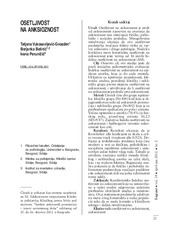Prikaz osnovnih podataka o dokumentu
Osetljivost na anksioznost
Anxiety sensitivity
| dc.creator | Vukosavljević-Gvozden, Tatjana | |
| dc.creator | Batinić, Borjanka | |
| dc.creator | Peruničić, Ivana | |
| dc.date.accessioned | 2021-10-12T11:31:19Z | |
| dc.date.available | 2021-10-12T11:31:19Z | |
| dc.date.issued | 2012 | |
| dc.identifier.issn | 0351-2665 | |
| dc.identifier.uri | http://reff.f.bg.ac.rs/handle/123456789/1411 | |
| dc.description.abstract | Uvod: Osetljivost na anksioznost je strah od anksioznosti zasnovan na uverenju da anksioznost ima oštećujuće fizičke, psihološke i socijalne posledice. Mnogobrojna istraživanja ukazuju da ova osetljivost predstavlja značajan faktor rizika za razvoj anksiozne i druge patologije. Najčešće korišćena mera konstrukta osetljivosti na anksioznost jeste verzija od 16 stavki Indeksa osetljivosti na anksioznost (ASI). Cilj: Osnovni cilj ove studije jeste da pruži inicijalnu psihometrijsku evaluaciju Indeksa osetljivosti na anksioznost na srpskom uzorku, koja je do sada izostala. Uključeni su ispitivanje pouzdanosti, faktorska analiza, poređenje kliničke i nekliničke grupe prema stepenu osetljivosti na anksioznost, i utvrđivanje da li osetljivost na anksioznost predviđa crtu anksioznosti. Metod: Uzorak čine dve grupe ispitanika: klinička grupa (N=104) kod koje je dijagnostikovan neki od anksioznih poremećaja i neklinička grupa (N=102) koja je sa prethodnom ujednačena po polu i uzrastu. Većina ispitanika u uzorku (70.4%) je ženskog pola, prosečnog uzrasta 36.23 (SD=9.47). Zadati su Indeks osetljivosti na anksioznost i Spilbergerov inventar anksioznosti kao crte. Rezultati: Rezultati ukazuju da je Kronbahov alfa koeficijent za skalu u celini veoma visok (vrednost alfe 0.923). Dobijena je trofaktorska struktura koju čine strahovi u vezi sa fizičkim, psihološkim i socijalnim aspektima anksioznosti i ustanovljen jedan faktor višeg reda. Takođe je utvrđena značajna razlika između kliničkog i nekliničkog uzorka na celoj skali, kao i na svakom faktoru. Regresiona analiza pokazala je da fizička i psihološka zabrinutost predstavljaju značajan prediktor crte anksioznosti dok socijalna zabrinutost nema udela. Zaključak: Karakteristike Indeksa osetljivosti na anksioznost koje su ustanovljene u našoj sredini odgovaraju nalazima prethodno obavljenih studija u inostranstvu. Ovaj instrument predstavlja adekvatnu meru ovog konstrukta u našoj populaciji tako da se može koristiti u kliničkom setingu i daljim istraživanjima. | sr |
| dc.description.abstract | Introduction: Anxiety sensitivity is fear of anxiety based on belief that anxiety has damaging physical, psychological and social effects. Numerous researches point to the fact that this sensitivity represents a significant risk factor for the development of anxious and other pathologies. The most often used measure of the construct of anxiety sensitivity is version of 16-item Anxiety Sensitivity Index. Objective: This study aims to make initial psychometric evaluation of the Anxiety Sensitivity Index on a Serbian sample, which has not been carried out so far. Reliability testing, factor analysis, the comparison of a clinical and non-clinical group by anxiety sensitivity level and establishing whether anxiety sensitivity may predict trait anxiety are included. Method: The sample comprises two groups of subjects: a clinical group (N=104) diagnosed with an anxiety disorder and a non-clinical group (N=102) of the same sex and age as the former. The majority of the subjects in the sample (70.4%) are female and their average age is 36.23 (SD=9.47). The Anxiety Sensitivity Index and Spielberger Trait Anxiety Inventory have been set. Results: The results indicate that the Chronbach's alpha coefficient for the entire scale is very high (the value of alpha being 0.923). A three-factor structure composed of fears in relation to physical, psychological and social aspects of anxiety has been obtained and a higher-order factor has been established. Moreover, a significant difference between the clinical and the non-clinical sample has been observed on the entire scale as well as on each factor. Regression analysis has shown that physical concern and psychological concern are significant predictors of trait anxiety, while social concern does not play a part. Conclusion: The characteristics of the Anxiety Sensitivity Index which have been established in our environment correspond to the results of studies previously carried out abroad. This instrument is an adequate measure of this construct in our population and thus it can be used in the clinical setting and further research. | en |
| dc.publisher | Klinički centar Srbije - Klinika za psihijatriju, Beograd i Udruženje psihijatara Srbije, Beograd | |
| dc.rights | openAccess | |
| dc.source | Engrami | |
| dc.subject | osetljivost na anksioznost | sr |
| dc.subject | anksioznost | sr |
| dc.subject | anxiety | en |
| dc.subject | anxiety sensitivity | en |
| dc.title | Osetljivost na anksioznost | sr |
| dc.title | Anxiety sensitivity | en |
| dc.type | article | |
| dc.rights.license | ARR | |
| dc.citation.epage | 34 | |
| dc.citation.issue | 2 | |
| dc.citation.other | 34(2): 23-34 | |
| dc.citation.rank | M52 | |
| dc.citation.spage | 23 | |
| dc.citation.volume | 34 | |
| dc.identifier.fulltext | http://reff.f.bg.ac.rs/bitstream/id/365/1408.pdf | |
| dc.identifier.rcub | https://hdl.handle.net/21.15107/rcub_reff_1411 | |
| dc.type.version | publishedVersion |

